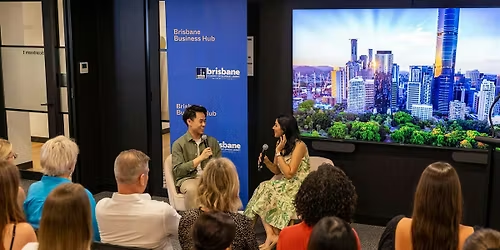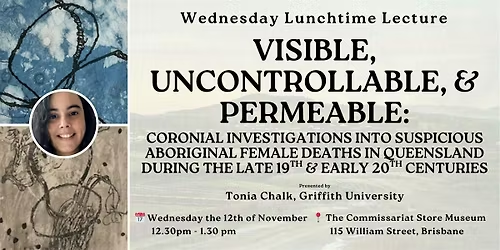WLL Coronial Investigations into Suspicious Aboriginal female deaths in QLD
Schedule
Wed Nov 12 2025 at 12:30 pm to 01:30 pm
UTC+10:00Location
The Commissariat Store Museum | Brisbane City, QL

About this Event
Lecture Summary:
During the late nineteenth and early twentieth centuries coronial investigations into suspicious deaths in Queensland involved documenting the details of the deceased in a Certificate of Particulars, presenting the chief investigator's findings, recording the testimonies of witnesses before and after death, and attaching a Medical Officer's report. Terms like "half caste," "gin," "abo," and "domestic" were frequently used in inquests involving Aboriginal women and girls as a kind of nullius or erasure in the archival record. Visualising the Aboriginal female corpse through colonial and coronial discourses meant the body was examined for its desirability and sexual promiscuity through clothing, and marks of violence on the skin. Furthermore Aboriginal women and girls were identified as ‘half caste’ through blood quantum implying they were visible through their transparent skin, controlled/’protected' due to their sexual nature, and overwhelmingly permeable as the dying race.
This paper will interrogate how Aboriginal female bodies were examined in coronial investigations through a focus on blood, dress, and movement. Testimonies from witnesses in death inquests make this clear by describing the women and girls' clothing, whether they were inside or outside the house, and the events surrounding their last moments. The three illustrative examples provided include the death of my 30-year-old great-great-great-great grandmother in 1890 in Eulo SW Queensland by strychnine poisoning, thought to be suicide. In her inquest it is noted that she was wearing a pink and white dress when she died, even though her body had been decomposing in the SW Queensland heat for three days before Constable Allison, not a Justice of the Peace, arrived to investigate. In 1907 a 15-year-old ‘half caste’ girl from Gigoomgan was described as having “her boots on and was nicely dressed” before she was raped and died as result of her injuries, with no one accused. In 1944 in Palm Island, a 35-year-old domestic is noted as wearing a Milanese petticoat, singlet, and pantees, while drenched in kerosene and about to commit suicide by setting herself on fire. Through descriptions of underwear, clothing, and colour in the inquest, colonial and coronial discourses were primarily focussed on the Aboriginal female body in terms of transparent skin, visible interiors, and their inherently sexual nature.
Speaker Bio:
Tonia Chalk is a First Nations woman from SW Queensland, whose ancestors lived and worked as Aboriginal domestic servants and stockmen on Budjiti, Kunja, and Gunggari country. She currently lives on Giabal, Jarowair, and Western Wakka Wakka country, known as Toowoomba, and is a Lecturer in the School of Education at the University of Southern Queensland. Tonia is a confirmed PhD candidate in the Griffith University School of Humanities.
Tonia’s thesis investigates the coronial records of eleven Aboriginal women and girls who died in suspicious circumstances in Queensland during the late nineteenth and early twentieth centuries. Her unique analysis of the archive aims to give voice to Aboriginal girls and women whose lives and violent deaths have been silenced in colonial coronial records. By challenging the legacies of racism, colonial power and coronial biases, her re-interpretation of inquest files seeks to humanise and personalise these women and girls. It is through remembering the deceased as a living person in the inquest that we can begin to understand the agency of Aboriginal women and girls during this period and take ownership of those narratives in Aboriginal family stories, including her own.
Where is it happening?
The Commissariat Store Museum, 115 William Street, Brisbane City, AustraliaEvent Location & Nearby Stays:
AUD 0.00 to AUD 10.00










